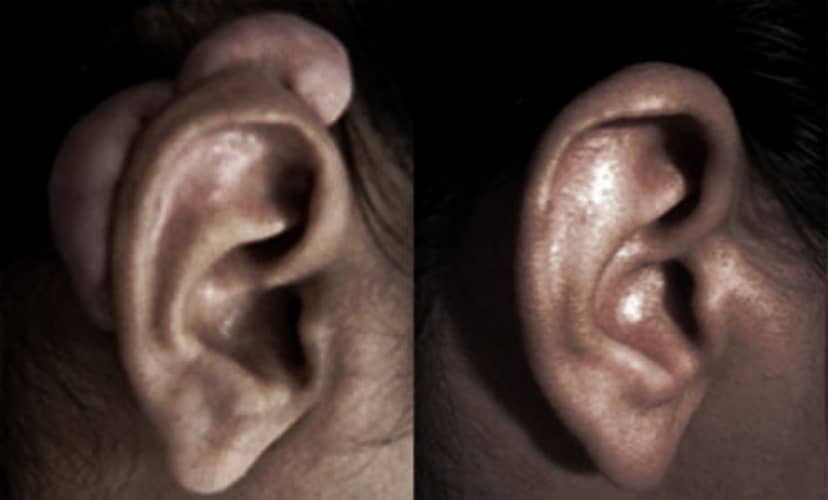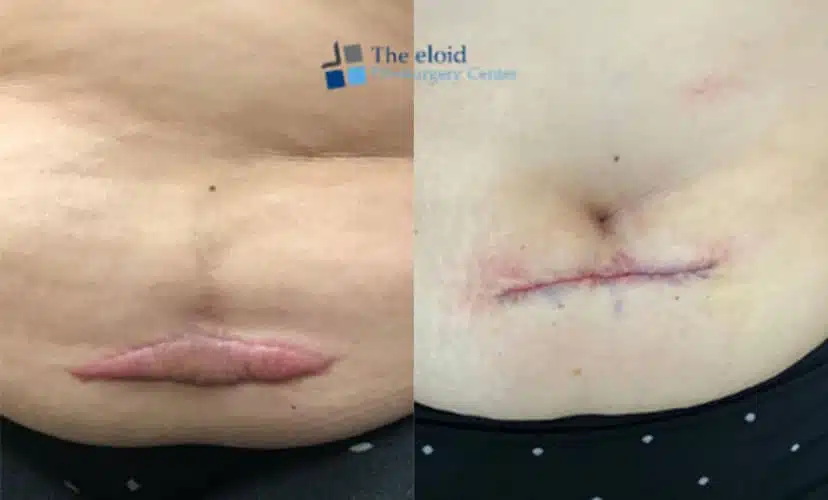Heart surgery is one of the most common procedures in the US today, with over half a million surgeries performed yearly. Unfortunately, keloids or hypertrophic scars are one of the most common and long-lasting side effects of coronary bypass surgery. Keloids are raised, fibrous, and ridged scars that become visible after the healing process following surgery. Excess amounts of the protein known as collagen in the skin result in the formation of keloids.

Why
Why Do Cardiac Surgery Keloids Form?
Keloids are a type of scar that results from an abnormal wound-healing response to skin trauma or injury and excessive collagen production. They are fairly common, affecting about 10% of the population. Anything from a minor cut or scrape to an open heart surgery wound can lead to the development of a keloid. Moreover, keloid scars can happen anywhere in the body, but those who are prone to keloids usually get them on the chest region, earlobes (especially after they have been pierced), neck, and shoulders.
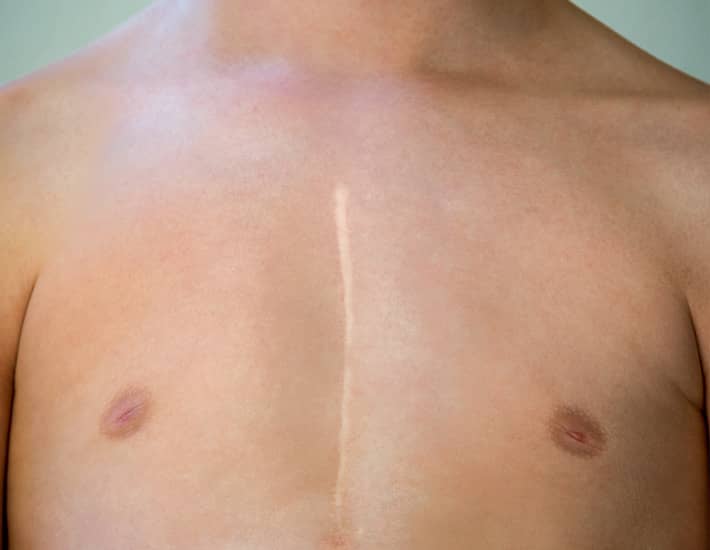
Post-heart surgery keloid scars can grow far beyond the initial surgical wound. Some of them are itchy, but they are rarely painful. In appearance, keloids can look thick and raised lumpy, flesh-colored, red, purple, and bright pink, or with darker pigmentation. And while surgical scars are not generally harmful to your physical health, they can cause quite a bit of emotional distress and may negatively affect your self-image and self-esteem.
Everyone can develop keloids, but some populations carry a high risk of the appearance of scars than others:
- Patients under 30 years of age
- People of Black African, South Asian, or Caribbean descent
- Patients undergoing surgery for heart diseases or have skin injuries
- People with a personal or family history of keloids

Types Scars
Types Of Open Heart Surgery Scars
Heart surgery can leave prominent scars that can cause significant emotional distress – especially if said scar later develops into a keloid. Any of the following heart surgery scars can turn into a keloid in at-risk individuals.
Median Sternotomy Scar
Can measure anywhere between 8 to 11 inches and runs from the top to the bottom of the sternum.
Pacemaker Scar
About 2 inches long, just below the collarbone.
Posterolateral Thoracotomy Scar
Right below the tip of the shoulder blade, measuring about 6 inches.
Anterolateral Thoracotomy Scar
About 6 inches long, runs from below the shoulder blade toward the front or side of the chest
Axillary Scar
Right below the underarm can measure up to 3 inches
BEFORE & AFTER GALLERY
Natural & Unparalleled Results
Surgeries performed by renowned plastic surgeon Roberto J. Mendez M.D. and double board-certified plastic surgeon Dr. Gabriel Salloum in Miami Beach, FL

Contact
Schedule a Consultation
If you are wondering how to remove a keloid, call 1 (833) 453-5643 or contact us at The Keloid Plastic Surgery Center today to schedule a consultation for your post-heart-surgery keloid treatment in our medical facility. Plastic Surgeons Dr. Mendez and Dr. Salloum combined have been treating keloids for over 40 years and have the knowledge and experience needed to provide you with outstanding care and results.
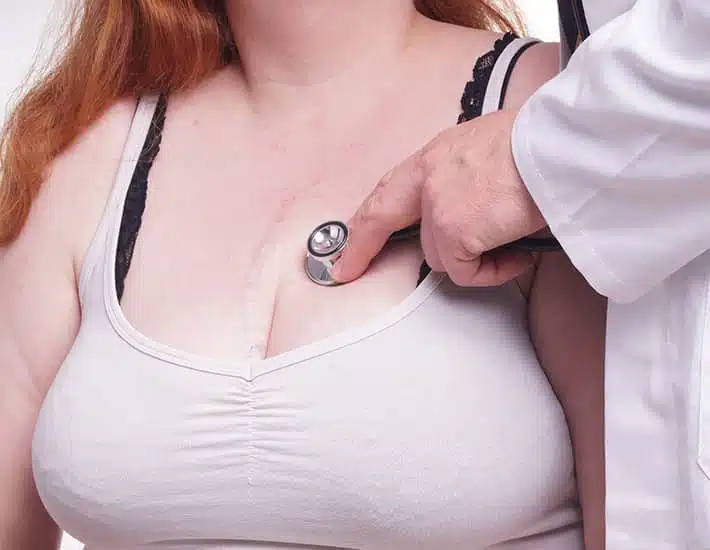
Best Treatment
Best Treatment For Post-Heart Surgery Keloids and Scars
Keloid formation following cardiac bypass surgery can cause a significant amount of discomfort and pain. Thankfully, there are effective methods for keloid treatment and removal. At The Keloid Plastic Surgery Center, we offer various non-surgical and surgical options for open heart surgery scars care. Dr. Roberto Mendez and Dr. Gabriel Salloum are board-certified plastic and reconstructive surgeons who specialize in the treatment of scar tissue.


Keloid Removal Surgery
Typically reserved for larger keloids, the excision procedure is an invasive surgery that involves carefully cutting out the keloid or excess tissue. Since this method involves creating a new incision on the skin, it has a high recurrence rate when performed on its own. The doctors at The Keloid Plastic Surgery Center recommend combining the surgical removal of keloid scars with other treatments.

Intralesional Steroid Injections
Intralesional injections deliver medication directly into the keloid to reduce the scar size and improve its lumpy appearance. This treatment modality is usually combined with surgical excision of the keloid to lower the chances of recurrence.

Superficial Radiation Therapy (SRT)
Since keloids are types of scar known as non-malignant tumors, radiation therapy is an appropriate option to treat them. Superficial Radiation Therapy (SRT) is one of the safest and most effective solutions for the treatment of post-heart surgery keloids and other complex scars.
For those who want to avoid the risks associated with keloid surgical excision, low-dose radiation therapy (S.R.T.) is a reliable treatment option for keloids. The technique works by delivering controlled doses of radiation directly to the affected area, which helps inhibit collagen production and prevents new hypertrophic scar formation.
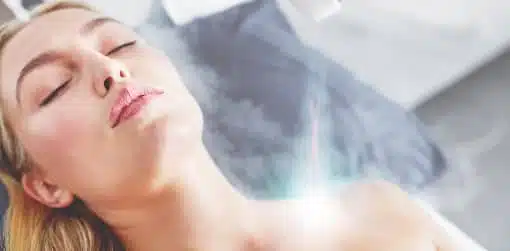
Cryotherapy
Also known as cryosurgery or cold therapy, this therapeutic approach to treating surgical scars involves applying liquid nitrogen at freezing temperatures to destroy keloid-forming cells. If you want to avoid invasive procedures, this scar treatment may be a good option because of its faster recovery after a session.
Cryotherapy is a great option , especially to reduce redness in scars. It reduces inflammation by freezing the extra scar tissue and destroying it. This helps to minimize the visibility and texture of a scar and can help improve overall skin tone. Depending on the size of the scar, multiple treatments may be needed to achieve desired results.
keloid Treatments
Combine Treatments to Remove Heart Surgery Keloids
Keloid formation following cardiac bypass surgery can cause a significant amount of discomfort and pain. Thankfully, there are effective methods for keloid treatment and removal. At The Keloid Plastic Surgery Center, we offer various non-surgical and surgical options for open heart surgery scars care. Dr. Roberto Mendez and Dr. Gabriel Salloum are board-certified plastic and reconstructive surgeons who specialize in the treatment of scar tissue.

FAQs
FAQs About Keloid Cardiac Surgery Treatment

TESTIMONIALS
What our Patients say

Why Choose Plastic Surgeon Dr. Mendez?
- Board certified plastic surgeon for more than 20 years
- Certified by American Board of Plastic Surgery
- Member of the American Society of Plastic Surgeons
- Fellow of the American College of Surgeons
- Graduate of Saint Louis University and Ponce School of Medicine
Why Choose Plastic Surgeon Dr. Salloum?
- Double-board certified plastic surgeon by The American Board of Surgery and The American Board of Plastic Surgery
- Training at Vanderbilt University in Nashville, TN
- Residency at the Mount Sinai Medical Center
- Plastic Surgery Program at the University of Texas at Houston
Last modified by Dr. Gabriel Salloum
